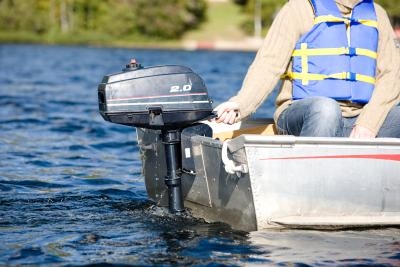
Outboard boat motors endure a lot more stress, heat and wear than automobile engines. Usually operated at full-throttle, outboard motors do not idle or coast often. Contained in the power-head of the outboard motor, the piston receives the highest stresses and heat during operation. Several issues, all related to stress and heat, can cause a piston in an outboard motor to break.
Oil used in an outboard motor must keep its viscosity (thickness) and lubricating qualities to form a protective barrier between major engine components such as rod bearings, piston pins and crankshaft bearings. If the oil becomes contaminated, it allows metal-to-metal contact between engine parts, particularly the piston and rod. Inadequate lubrication causes friction and excess heat, which can expand the piston skirts and jam it in the cylinder head, cracking the piston.
In an outboard motor, a connecting rod attaches the piston to the crankshaft to allow reciprocal motion. The large end of the connecting rod connects to the crankshaft. If the connecting rod bearings receive little or no lubrication, they become worn and open a gap between the rod bearing and the crankshaft journal. Such an opening will cause a pounding effect that gets progressively worse until the rod snaps free. The force of the break can send the rod upward to strike and break the piston.
A piston pin connects the top of the connecting rod to the body of the piston. It allows the piston to rotate on its axis, while the lower part of the connecting rod follows the rotation of the crankshaft. If the piston pin bearing sleeves wear, the rod can break free from it and fly upward to puncture a hole through the piston body or skirt.
Piston rings function as circular metal seals that keep combustion gases from passing out of the piston into the crankcase. If the piston rings bind or gall as a result of wear, age or lack of lubrication, they can break off in pieces and become trapped between the piston top and cylinder head. The collision of the broken ring and piston frequently cracks the piston face or edges.
Pre-ignition can occur in two-stroke or four-stroke outboard motors. It happens when the air-fuel mixture introduced into the combustion chamber ignites prematurely. Pre-ignition occurs when a hot spot develops on the piston face, valves or cylinder head. The hot spots can also be caused by glowing deposits anywhere in the combustion area. Spark plugs that have the wrong heat range, or have worn electrodes, can cause pre-ignition. If prolonged, pre-ignition will cause a weakening of the piston face, leading to metallurgical failure.
Detonation occurs in the combustion chamber after the cylinder has fired. It results from a violent collision of one or more flames fronts which can cause an abrupt explosion. Heavy carbon deposits on top of the piston or valve faces, a lean air-fuel mixture, overly advanced timing and low octane fuel can all cause detonation. Detonation can be identified by an audible spark or carbon "knock" inside the power head. Serious cases of detonation can drive a hole down through the middle of the piston.
If the outboard motor overheats as a result of a broken water pump impeller, rust-filled water passages or clogged raw water intake ports, the overall engine temperature can rise and overheat the piston. An overheated piston can freeze in the cylinder wall due to sever galling and cause the connecting rod to break free. An overheated engine can cause minute cracks in the piston body, due to the extreme expansion and contraction of the piston metal.
Gas that has sat dormant for over three months can cause heavy gum and varnish deposits in the cylinder. The deposits can accumulate on the top of the piston, attracting carbon buildup. The additional deposits can become thick enough to raise the combustion ratio of the cylinder and cause overheating, pre-ignition or detonation. In addition, gas that has over 10 percent alcohol will cause piston overheating, leading to cracks or catastrophic piston failure.
Outboard motors that require a mixture of oil to gas can suddenly overheat and disintegrate the piston if the ratio mix is not correct. A two-stroke outboard motor that does not have enough oil in the fuel mixture will run hot, increasing the temperature of the piston, valves and piston rings. Two-stroke outboard motors have no way to lubricate the upper power-head components, other than the fuel and oil mixture which enters the combustion chamber.
An outboard motor has intake and exhaust valves that intake fuel and expel combustion gases. The valves have springs and keepers to hold them in place. If a keeper or valve spring breaks, it allows the the valve to float freely and strike the top of the piston. These impacts can crack the pistons and freeze the motors.